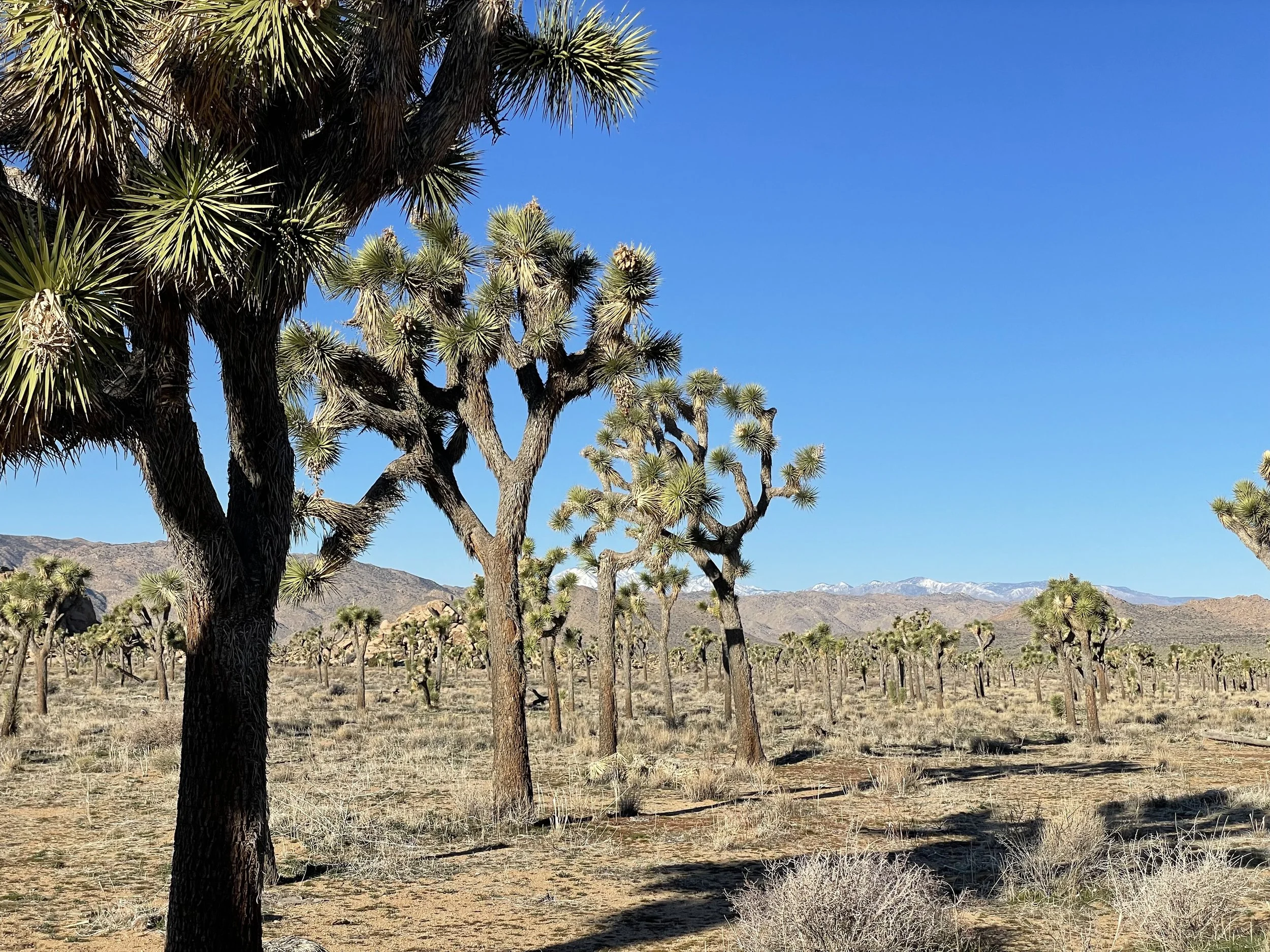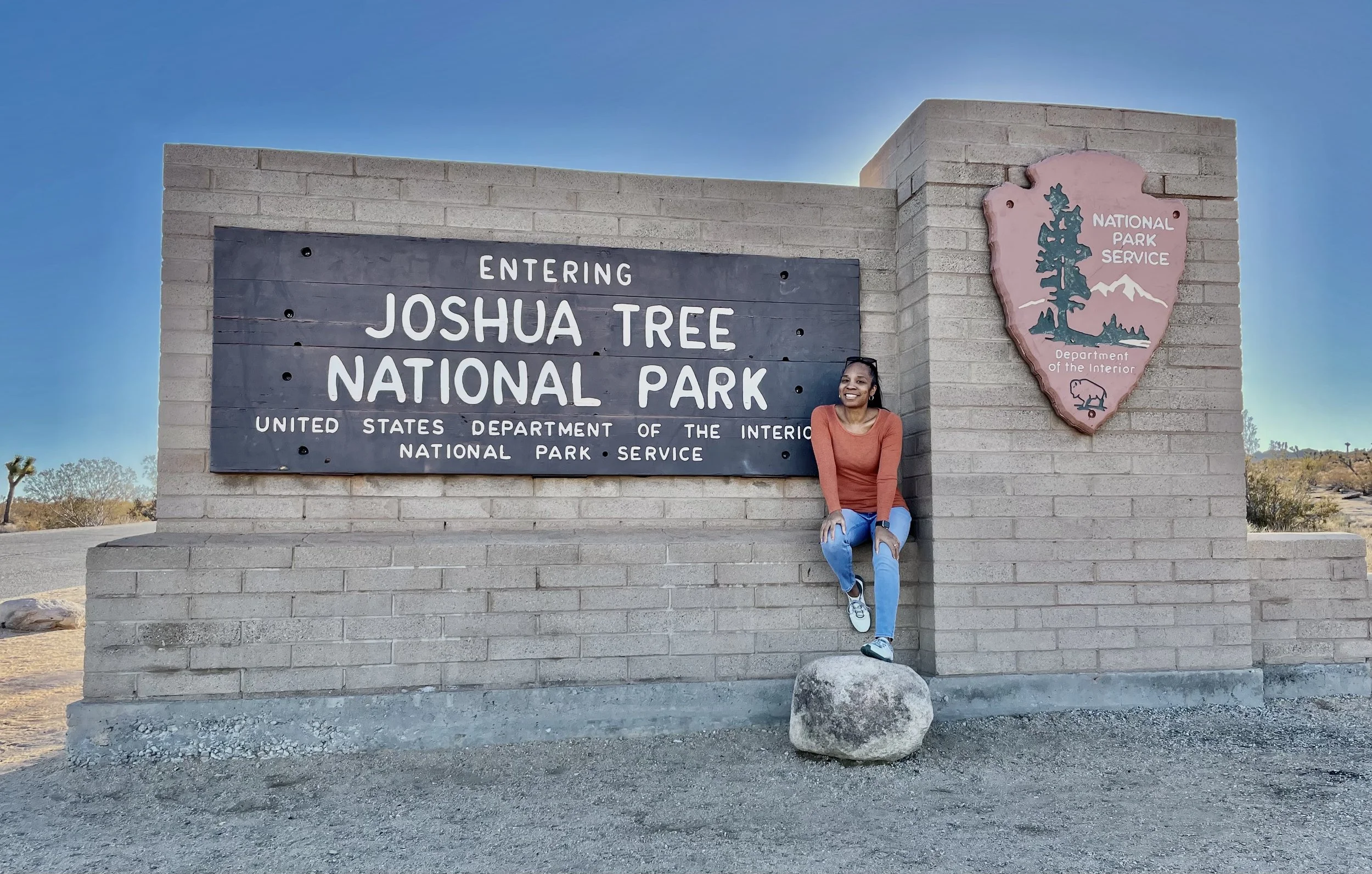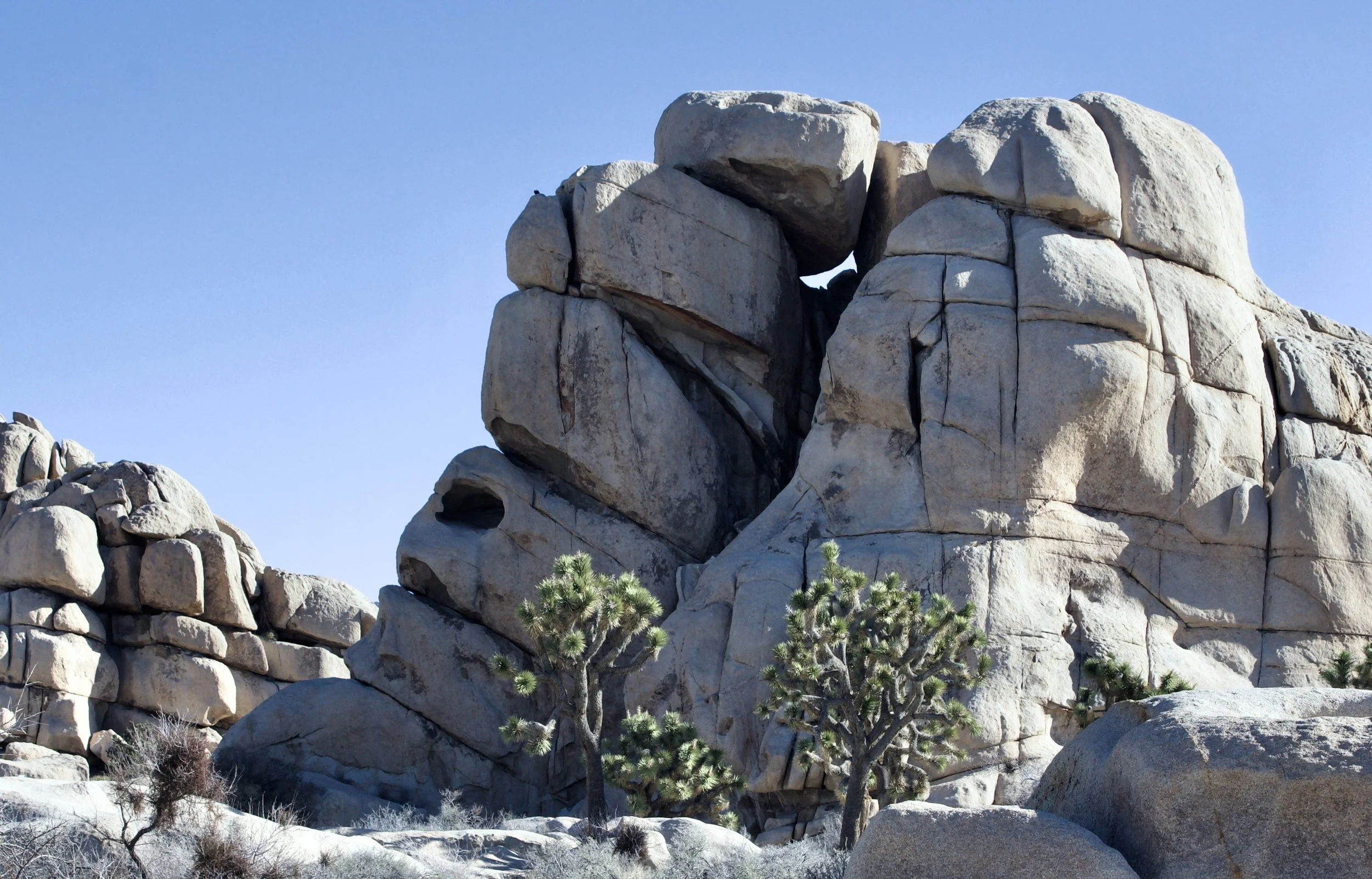#11 Joshua Tree National Park, California
Joshua Tree National Park will forever be etched in my memory as the place where I nearly sat on a black widow spider. How did that happen, you ask? Let me take you through my early morning adventure.
I arrived at Joshua Tree on a crisp January morning, eager to catch the sunrise over the park’s rugged landscape. Before heading into the park, I stopped by the Joshua Tree Visitor Center, just a mile from the entrance, to grab my stamp and maps. It’s a great spot to get oriented, offering helpful exhibits about the park’s natural and cultural history.
With maps in hand, I drove to the park entrance. I had to pulling over to snap a photo with the Joshua Tree National Park sign. After posing, I stood up—only to spot a black widow spider crouching in the corner of the sign’s ledge. My heart almost stopped as I realized how close I had come to an unfortunate encounter. Grateful for my luck, I warned the visitors behind me of the inconspicuous occupant before continuing my journey into the park.
About Joshua Tree National Park
Located in southeastern California, Joshua Tree National Park spans over 790,000 acres, where the Mojave and Colorado Deserts converge. It’s a place of stark beauty, with twisted Joshua Trees (Yucca brevifolia) giving the park its name, as well as fascinating rock formations, rich wildlife, and some of the clearest night skies in the U.S.
The park is renowned for attracting rock climbers, hikers, and stargazers, all drawn to its sprawling landscape and beautiful vistas.
Notable Highlights
Joshua Trees: These unique trees with spiky, twisted branches are a signature of the park and a symbol of the American Southwest.
Rock Formations: The park is famous for its giant boulders and natural formations, like Skull Rock, Arch Rock, and Hidden Valley, which also double as prime rock climbing and photography spots.
Wildlife: Joshua Tree is home to desert tortoises, bighorn sheep, coyotes, and a variety of bird species. Of course, black widow spiders also reside here, though they’re not typically in the tourist hotspots!
Stargazing: As a Dark Sky Park, Joshua Tree offers exceptional stargazing, with minimal light pollution making it perfect for viewing the Milky Way and meteor showers.
Climate: The park has a desert climate with hot summers and chilly winters, especially in the mornings and evenings, so come prepared for varying temperatures.
Visitor Centers
There are 3 visitor centers around Joshua Tree:
Joshua Tree Visitor Center: Located just a mile from the park entrance, this is the main center, offering maps, information on hiking and climbing, and a gift shop.
Barker Dam Visitor Center: Located near Barker Dam, this center focuses on the park’s cultural history, including water sources and early human habitation.
Cottonwood Visitor Center: Found at the park’s southern entrance, this center offers information about the southern desert and its wildlife.
Park Fees
Vehicle Entrance Fee: $30 per vehicle, valid for 7 days.
Motorcycle Entrance Fee: $25 per motorcycle, valid for 7 days.
Individual Entrance Fee: $15 per person (on foot, bike, or horseback), valid for 7 days.
Annual Pass: $55 for unlimited entry for one year.
Additional fees may apply for special activities, and it’s worth checking the park’s website for up-to-date info on seasonal changes or closures.
Must-See Sights and Hikes
Joshua Tree offers a variety of trails and viewpoints, ranging from easy strolls to challenging treks. Here are a few of the park’s best sights:
Hidden Valley: This popular loop trail is an excellent introduction to the park’s rock formations and desert flora. It’s also a favorite spot for rock climbers.
Skull Rock: A quirky rock formation shaped like a skull, perfect for a quick photo op.
Keys View: One of the park’s best panoramic viewpoints, offering sweeping vistas of the Coachella Valley and, on clear days, even Mexico.
Cholla Cactus Garden: A surreal landscape filled with dense clusters of cholla cacti. It’s especially magical at sunrise or sunset.
Barker Dam: A relatively easy hike leading to a historic water reservoir built by early cattle ranchers. Depending on the season, you may even spot bighorn sheep near the water.
Arch Rock: A short hike to a natural rock arch, perfect for photographers and hikers.
Ryan Mountain: For a more challenging experience, this strenuous hike offers incredible 360-degree views from the summit.
Keys Ranch: A preserved 19th-century homestead offering guided tours that provide insight into the lives of early settlers.
Best Hikes by Difficulty
Easy Hikes:
Skull Rock Trail (1.7 miles, loop)
Cholla Cactus Garden Trail (0.25 miles, loop)
Hidden Valley Trail (1 mile, loop)
Barker Dam Trail (1.3 miles, loop)
Arch Rock Trail (1.4 miles, out & back)
Moderate Hikes:
Mastodon Peak Trail (3 miles, loop)
Lost Horse Mine Trail (4 miles, out & back)
Wall Street Mill Trail (2.4 miles, out & back)
Challenging Hikes:
Ryan Mountain Trail (3 miles, out & back)
Lost Palms Oasis Trail (7.5 miles, out & back)
Boy Scout Trail (8 miles, point-to-point)
Skull Rock
Best Photography Spots
For Sunrise:
Cholla Cactus Garden – The golden light creates a beautiful contrast with the cacti.
Keys View – A fantastic spot for catching the sun rising over the Coachella Valley.
For Sunset:
Hidden Valley – The rock formations glow as the sun sets.
Skull Rock – The evening light adds dramatic shadows, perfect for photos.
For Night Photography:
Arch Rock – The arch beautifully frames the Milky Way.
Hidden Valley – Ideal for astrophotography with minimal light pollution.
Belle or White Tank Campgrounds – These quieter spots offer great foreground elements for night shots.
Best Camping Spots
Joshua Tree’s campgrounds offer access to stunning views and great hikes:
Hidden Valley Campground: Popular among climbers and centrally located to major routes. First-come, first-served.
Jumbo Rocks Campground: A popular choice with massive boulders and great stargazing.
Belle Campground: A quieter option, perfect for astrophotography.
White Tank Campground: Remote and close to Arch Rock for great photography opportunities.
Cottonwood Campground: Located near the southern entrance, ideal for exploring the Lost Palms Oasis Trail.
The cost of camping at Joshua Tree National Park varies depending on the campground and whether you have a reservation. Here are the general rates:
Campground Fees:
$20 per night for standard campsites at most campgrounds (Hidden Valley, Jumbo Rocks, Ryan, Belle, White Tank, and Black Rock).
$25 per night for group campsites at locations like Cottonwood and Black Rock (for larger groups of 9–25 people).
Backcountry Camping:
Free (permits required for backcountry camping, which can be obtained at the park visitor centers).
Reservations:
Most campgrounds operate on a first-come, first-served basis, but a few campgrounds (like Cottonwood Springand Black Rock) accept reservations through Recreation.gov.
Jumbo Rocks and Hidden Valley can be especially busy during peak season (fall and spring), so it’s recommended to arrive early or secure a reservation.
Best Rock Climbing Spots
Intersection Rock – A classic destination with a variety of routes.
Echo Rock – Great for beginners with accessible climbs.
The Wonderland of Rocks – Remote and challenging, with fewer crowds.
Hemingway Buttress – Perfect for intermediate climbers looking for sport climbs.
The Split Rock Area – Offers cracks and face climbs for all levels.
There is no additional fee for rock climbing at Joshua Tree National Park beyond the standard park entrance fees. This includes access to all climbing areas within the park.
However, if you choose to hire a guide or take a guided climbing tour, those services will come with their own fees. Climbing schools and guide services, such as Joshua Tree Rock Climbing School, offer lessons and guided climbs for various skill levels, and pricing typically ranges from around $100 to $300 per person, depending on the duration and type of service.
It's important to note that climbing permits are not required for most climbing areas.
Best Wildlife Spotting Locations
Barker Dam Trail – A great spot to see bighorn sheep.
Keys View – Ideal for spotting birds of prey.
Cottonwood Spring – A desert oasis with migratory birds and bobcats.
Hidden Valley – A great spot for jackrabbits, coyotes, and desert tortoises.
Cholla Cactus Garden – At dawn or dusk, you might spot nocturnal creatures like kangaroo rats.
For the most up to date info on the park visit the National Park Service Website




